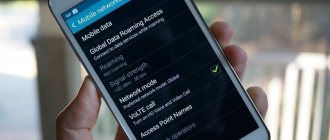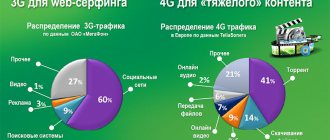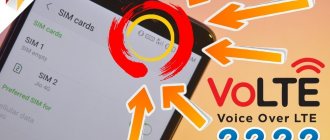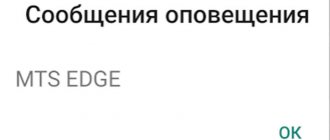4G technology provides users with a high-quality and stable signal, and also allows them to access high-speed Internet. When purchasing a new device, not everyone pays attention to which networks the device supports. Studying the specifics of how a smartphone works gives you an understanding of how the device will receive signals from base stations and whether there will be delays when talking using Wi-Fi Calling or VoLTE technology. To ensure that subscribers can use communications comfortably, LTE standards have been developed. Currently there are two options FDD and TDD. To understand the principle of their operation, you should understand in detail the question of what LTE FDD and TDD are.
What is LTE FDD
Many people ask FDD LTE - what is it? This parameter indicates the type of data packet transmission that uses duplex frequency division. If this parameter is used in a smartphone, then the device transmits packets using different frequencies. For example, category BAND 3 (band - frequency), here the frequency of 1710 MHz is used to transmit packets and receive 1810 MHz. If we take a more obvious example, they can serve as a highway divided into two lanes, where traffic is carried out in one direction.
LTE FDD and TDD technology
For your information! If FDD is used, then transmission and reception are carried out in different frequency ranges, so opposing waves do not create additional interference. Thus, signal reception occurs without delay, and the throughput is significantly higher.
At the moment, most operators operating in the country use this technology. This is due to the low cost of maintenance and a more stable signal.
What you need to know about 4G
What is 4G (LTE)? According to Wikipedia, LTE (literally Long-Term Evolution - long-term development, often referred to as 4G LTE) is a standard for wireless high-speed data transmission for mobile phones and other terminals that work with data (modems, for example). It increases throughput and speed by using a different air interface along with improving the network core. The standard was developed by 3GPP (a consortium that develops specifications for mobile telephony). The LTE wireless interface is not compatible with 2G and 3G, so it must operate on a separate frequency. In Russia, three frequency ranges are allocated for LTE - 800, 1800 and 2600 MHz.
What is LTE TDD
How to boost a 4G signal yourself - description of methods
Also, many are interested in the question, LTE TD - what it is and how it works. The technology implies that the same frequencies are used to transmit and receive data packets for time separation. To eliminate any interference and minimize signal delay, transmission is carried out non-continuously.
In some cases, the phone or basic cellular repeater can only receive or transmit a signal. As an example, consider the BAND 30 standard, which uses the same frequency for receiving and transmitting radio signals at 2600 MHz. To make it more clear, we can again take a specific example - a highway where there is only one lane, but in the morning drivers can only drive in one direction, and in the evening in the other.
Base station
The TD LTE standard has a number of disadvantages due to the use of only one channel. As a result, signal delay increases and throughput decreases. If the mobile operator uses this particular standard, then different time intervals are set for transmitting and receiving data (5 ms and 10 ms).
Note! Signal delay is most pronounced when a subscriber is communicating with another user via VoLTE.
This LTA standard is used by mobile operators only if there are no frequencies available, but maximum network coverage is required. The standard is applied in the largest cities where there is a relatively high population density. In rural areas, the use of TDD LTE does not make sense, there are not many active subscribers, and because of this, more frequencies can be used to receive and transmit data packets.
Important! Some wireless routers only support BAND 30, 38, and 40 standards.
Categorization of receiving devices
The frequency aggregation scheme is being actively developed by Russian providers, many agreements have been concluded on the mutual use of frequency ranges, and the antenna facilities of base stations are being reconstructed. However, there is one problem - on the receiving side, the subscriber must be able to receive a signal on several carrier frequencies simultaneously. Not all smartphones, tablets and modems support frequency aggregation and, therefore, cannot work in 4G+.
Starting from 2021, the documentation for smartphones indicates the frequency ranges (bands) and the LTE category in which they can operate. For example, for the 2021 smartphone Huawei P10 Plus, among other parameters, the following is indicated:
| 2G | 850/900/1800/1900 MHz |
| 3G | HSPA+ up to 42 Mbps |
| 4G | LTE Cat12 up to 600 Mbps |
| LTE frequencies | FDD: Band 1, 2, 3, 4, 5, 6, 7, 8, 9, 12, 17, 18, 19, 20, 26, 28; TDD: Band 38, 39, 40, 41 |
| Carrier Compatibility | MTS, Megafon, Beeline, Tele2, Yota |
In addition, this smartphone has a built-in IMO 4x4 antenna and a corresponding modem that allows it to process signals on two carrier frequencies at once. If your smartphone supports frequency aggregation, then the “settings” > “mobile network” tab will look something like this:
If so, then your smartphone supports LTE-A.
Thus, smartphone manufacturers have begun to catch up with mobile operators. Unfortunately, the same cannot be said about modem manufacturers. Until now, the most productive modem provides maximum speeds of 150/50 Mbit/s, i.e. belongs to Cat.4. So far this circumstance is not too upsetting, because... such speeds, if achieved in practice, deserve admiration. However, the mobile router industry appears to be catching up to smartphones. Cat.6 routers from Huawei and Netgeer (does not support Russian bands) began to appear on the market. So the Huawei E5787s-33a router can be bought on AliExpress for about 10 thousand rubles.
It must be said that the actual speeds achieved in 4G+ mode are far from the declared ones, but they are significantly higher than in simple 4G mode. The author conducted a number of experiments in Moscow, where it is not difficult to find LTE-A (Megafon operator), with a Cat.12 smartphone, the results of which are shown in the screenshots. The first screenshot is speeds for LTE-A (frequency aggregation is enabled), the second screenshot is for LTE (frequency aggregation is disabled). Let me note that for some reason, when taking a screenshot, the plus sign disappears from the 4G+ icon. I don’t know why, during testing there was a plus - see screenshot.
Six measurements were taken for each mode. Speeds with frequency aggregation enabled are on average noticeably higher, although not significantly higher. The measurements were carried out near the tower, during the day.
What is the difference between LTE FDD and LTE TDD
What is Smart TV on TV and Wi-Fi - description of functions
The main difference between FDD and TDD is the data transfer speed:
| Communication standard | Data transfer rate | Data reception speed |
| FDD | 50 Mb/sec | 100 Mb/sec |
| TDD | 68 Mb/sec | 17 Mb/sec |
How LTE works
Comparison of characteristics of TDD and FDD technologies:
| Specification | FDD | TDD |
| Radio frequency spectrum used | High spectrum including different frequencies | Low spectrum. This may mean that only one frequency is used |
| Technological complexity | High | Low. Dedicated time required for Downlink and Uplink channels |
| Signal delay | Minimum, up to 1 ms | High signal delay up to 10 ms. Also, this parameter will depend on what range is used to switch between TX-RX channels (reception/transmission) |
| Frequency range | Any frequency can be used. There are no restrictions | Only one frequency can be used, which is used alternately for receiving and transmitting data |
| Download and Upload configurations | Symmetrical data rate is used | The most commonly used is asymmetric packet transmission rate. This is necessary to reduce latency and increase speed over the Downlink channel |
| Dynamic Data Bandwidth Allocation | Not used, since several frequencies are used for Download and Upload | It is implemented for high-quality distribution of data transmission speed between several users in order to reduce signal delay. A simple example: if several users at the same time do not intensively use the traffic bandwidth, then it is distributed to the remaining subscribers, thereby increasing the speed. |
| Spatial coding method (only used to increase traffic bandwidth) | Sophisticated signal encoding to double traffic bandwidth | Lightweight spatial coding |
| Spatial filtering (automatic adjustment of signal strength depending on user location) | Complex | Lung |
Those wishing to experiment with LTE-A
If LTE-A has appeared in your area, which you have confirmed by measuring the frequencies of the operator you have chosen (the provider distributes the Internet at two frequencies, for example, LTE800 and LTE2600, i.e. uses the combination B7+B20) and you are itching to try what If this is the case, then you can try to use a scheme of two MIMO antennas with diplexers.
I note here that the NITSA-5 MIMO 2x2 antenna actually implements this design. The difference is that in NITSA-5 the function of diplexers is performed by the broadband emitters of the antenna themselves, because each of them receives suitably polarized signals from the 790÷960/1700÷2700 MHz bands simultaneously. Let me remind you that the mentioned antenna consists of two broadband feeds, separated by a certain distance and oriented so that their polarization vectors are orthogonal.
In general, this antenna is well suited for 4G+ reception at short distances (up to 5 km with line of sight to the BS), because allows reception of any combination of LTE-A frequencies and adapts 4x4 MIMO to common Cat.4 modems that only have two 2x2 MIMO inputs.
At what frequencies do these technologies operate?
Outdoor Wi-Fi access point: description, installation process
LTE technology operates on different frequency bands (BAND, or band). For FDD there are several bands: 1, 3, 7, 20, in turn for TDD - 33, 38, 40 and 44. In Russia, mobile operators use the following:
| Range | 1800 MHz | 2500 MHz | 800 MHz | 2600 MHz |
| BAND | 3 | 7 | 20 | 38/40 |
| Technology | FDD | FDD | FDD | TDD |
For your information! The LTE FD 800 MHz standard is used by mobile operators Megafon, Beeline and Tele2. This distribution is relevant for large cities where large network coverage is required. Almost all companies use the BAND 20 range.
Some users ask which is better: LTE 1800 MHz or LTE 2600 MHz. Thanks to the first, the signal penetrates better through various obstacles, such as concrete or steel walls. In turn, thanks to the second reception, the signal reception is better and more stable; there is also no need to use a large number of base stations, since their range reaches up to 20 km.
Frequency range
What is frequency aggregation
Frequency aggregation is the aggregation of spectrum. Thus, the signal is transmitted at several frequencies at once, and as a result there is virtually no delay and the speed of receiving and transmitting traffic packets increases. At the moment, this technology is used by the transitional generation 4G, which is referred to as 4G+ or 4.5G.
Note! Frequency aggregation allows devices to connect to multiple channels and combine them to improve signal quality and Internet connection speed.
Cat 1, cat 2, cat 3, cat 4… cat 12, cat 16 and others
Many people ask what CAT 4 LTE is. Today, most smartphone models use CAT4, which shows the maximum data transfer speed. This category allows you to achieve speeds of more than 50 Mb/sec, but several conditions must be met:
- be a few meters from the repeater;
- No third party subscribers should be connected to this point;
- the base station uses powerful equipment;
- The repeater uses an optical (fiber) connection to the network center.
In addition to LTE CAT 4, there are several more categories:
| Category | Transfer speed in Mb/sec |
| CAT4 | 150 |
| CAT6 | 300 |
| CAT9 | 450 |
| CAT12 | 600 |
| CAT16 | 980 |
Important! The CAT 4 LTE category shows information about what data rate the mobile phone supports.
LTE coverage in the world and the Russian Federation
The world is quite well covered with LTE networks. Technological leaders - South Korea, China, Japan and the USA are almost completely provided with the standard, even in the most remote areas. Europe is a little behind them. There are still places in Russia that can only be reached by bear. However, communication is needed there too. The only obstacle is the cost of implementation. It does not always correlate with the justification of installing a network in these remote places, since they will be used by 2 people per 1 hectare. It is worth considering the attitude of cellular operators towards the introduction of new technologies. Some keep up with progress and react quickly, while others are a little late and are in no hurry to install their towers. For example, this is what MegaFon’s 4G network coverage map looks like.
As you can see on the map, there are still quite a lot of areas not covered
Advantages and disadvantages of these technologies
Advantages and disadvantages of FDD:
| pros | Minuses |
| Most mobile operators use this technology | The reception and transmission channels are close together, so a guard band is needed |
| Splitting the signal allows you to improve Internet speed | Installation of filters to isolate frequencies from each other. Close proximity of channels can cause interference and reduced throughput |
| Significantly higher throughput | Due to the fact that transmission and reception are carried out on different channels, the speed may not be constant. |
| Radio waves can travel up to 10 km |
Data transfer rate depending on frequency aggregation
Using FDD technology reduces latency and increases Internet connection speed. To get a better and more stable signal, you need to purchase a device that supports BAND 3 and 7, since they work with FDD. When using TDD, you may experience inconsistent Internet connection speeds and an unstable signal.
Frequency aggregation
The word “aggregation” in this case means a union, i.e. Frequency aggregation is the combining of frequencies. I’ll try to explain what this means below. It is known that the transmission reception speed depends on the transmission channel width. As we saw from the table in the previous section, the download channel width, for example, of MTS is 10 MHz in the Band7 range (except Moscow), and the upload channel is also 10 MHz. To increase the download speed, the operator redistributes the frequencies he purchased in the ratio of 15 MHz for downloading and 5 MHz for uploading. Other providers do the same.
One day, one of the developers came up with a bright idea - what if the signal was transmitted not on one carrier frequency, but on several simultaneously. This expands the reception/transmission channel and the speed will theoretically increase significantly. And if each carrier is transmitted using the MIMO 2x2 scheme, then we get an additional gain in speed. This transmission and reception scheme is called “frequency aggregation”. It is this scheme that the 4G+ Internet or LTE-Advanced (LTE-A) uses.
The table indicates that for Cat.9, the transmitter and receiver must be able to transmit and receive signals on three carrier frequencies (in three bands) simultaneously, the width of each channel must be at least 20 MHz. For Cat.12, it is additionally necessary that the antenna devices be connected using a MIMO 4x4 scheme, i.e. actually you need 4 antennas on the receiving and transmitting sides. The mysterious 256QAM symbols mean a certain type of signal modulation that allows information to be packed more densely. Those wishing to familiarize themselves with this topic in more detail can begin to get acquainted with the material in the Wikipedia article and with the links there.
Russian Blogs
TD-LTE Technology and Its Applications
By Yvonne Liu and Bai Ying, Agilent Technologies, Inc.
Third-generation (3G) wireless systems are deployed all over the world. W-CDMA maintains a mid-term competitive edge by providing high speed packet access (HSPA) in both downlink and uplink modes. Typical cell maximum data rate today is around 7.2 Mbps, and typical single-user data rates of around 1.5 Mbps can be expected. To ensure competitiveness into the future, the long-term evolution (LTE) of the 3rd Generation Partnership Project's (3GPP) UMTS is first specified in release 8 of the 3GPP specification, and covers the emerging needs of “mobile broadband” into the next decade with cell data rates of over 300 Mbps expected when the system is fully functional.
Third generation (3G) wireless systems are deployed throughout the world. W-CDMA maintains a competitive advantage in the medium term by providing High Speed Packet Access (HSPA) in both downlink and uplink modes. Today, the typical maximum battery data rate is about 7.2 Mbps, and the typical single user data rate is about 1.5 Mbps. To ensure future competitiveness, the 8th edition of the 3GPP specification specified for the first time the Long Term Evolution (LTE) of the third generation partnership project (3GPP) UMTS, which covers new "mobile broadband" requirements in the next ten years. When the system is fully functional, its data transfer speed is expected to exceed 300 Mbit/s.
The majority of work to date on LTE has focused on the frequency division duplex (LTE FDD) variant. Following the integration of the Chinese TD-SCDMA standard, based on time division duplex (TDD), into the 3GPP specifications for LTE, chipset and device designers are now working to include TDD capability. Now known as TD-LTE, the standard allows carriers to make use of the unpaired spectrum that many of them already own.
Until now, most of the work on LTE has focused on frequency division duplex (LTE FDD) variants. . Time Duplex ( TDD ) Integration of Chinese TD-SCDMA standard, integration into LTE 3GPP specification, chipset and device developers are now working hard to include TDD functionality. Now called TD-LTE This standard allows operators to use unpaired spectrum, which many of them already own.
Compared to previous standards such as GSM/EDGE and W-CDMA, the timescale from first-generation standards documents to commercial release for LTE in general is short, and for TD-LTE in particular is shorter, due to its later addition into the standards . For handsets and data cards, LTE's maximum specified RF bandwidth of 20 MHz has driven a change in block diagram and the emergence of standard connections, while the requirement for multi-format devices which include compatibility with legacy systems may lead designers to the increased use of software-defined radios. New designs need more analog/digital cross-domain measurement and “digital-in, RF-out”, meaning designers need new tools and measurement methods.
With previous GSM/EDGE involving W-CDMA Compared to other standards, the timeline from first generation standard documents to commercial release of LTE is very short, especially TD-LTE Timeline is shorter because it was later added to the standard. For mobile phones and data cards, the maximum RF bandwidth specified by LTE is 20 MHz. ,Leading to changes in block diagrams and the emergence of ,standard interconnects, as well as multi-format device requirements, ,including compatibility with legacy systems, may encourage developers to ,use software-defined radios more frequently. New designs require more analog and digital cross-domain measurements and “digital in, RF out,” which means designers need new measurement tools and techniques.
TD-LTE is specified to operate in the frequency range 1850 to 2620 MHz, and uses the same MIMO scenarios and up- and down-link modulation formats as FDD: OFDMA (orthogonal frequency division multiple access) in the downlink and SC-FDMA ( single carrier frequency division multiple access) in the uplink. There are two frameconfigurations, each with an overall length of 10 ms and divided into 10 subframes, as shown below.
The “5ms” version has two special synchronizing subframes rather than the one in the “10ms” version, and gives greater opportunity for uplink/downlink flexibility. The frame can be dynamically configured to any one of the preset configurations shown, depending on the instantaneous data transmission requirement.
TD-LTE is designed to operate in the frequency range from 1850 to 2620 MHz. And use the same MIMO scheme and uplink modulation format as FD: OFDMA (Orthogonal Frequency Division Multiple Access) in the downlink and SC-FDMA (Single Carrier Frequency) in the uplink). There are two frames, each with a total length of 10 milliseconds and divided into 10 subframes as shown below. The "5 ms" version has two dedicated synchronization subframes instead of the subframes in the "10 ms" version and provides more uplink/downlink flexibility. To meet the requirements of instant data transmission, frame dynamics can be adjusted to any displayed preset configuration.
Figure 1: TD-LTE Frame Structures
Each one millisecond downlink subframe contains blocks of data (“resource blocks”) destined for a number of different users, while uplink subframes contain blocks of data from the users to the base station (eNB). The specified latency target (time from information request to reply) is 5 ms, or only half a frame, for small data packets, so system timing, including timing offset to compensate for distance from the eNB, is critical. The current system is optimized for low speed (stationary or pedestrian) users, who will see the highest-speed operation, but may eventually be extended to users traveling at up to 500 kph.
Every 1 millisecond, a downlink entry contains data blocks ("resource blocks") for several different users, and an uplink subframe contains data blocks from users to base stations ( eNB ) Data Block. for Small Packets , Specified Latency Target (time from request for information to response) Yes 5 ms , Or only half a frame, so system timing (including timing offset to compensate for distance from eNB) is very important. The current system targets low speed users (stationary or pedestrian) Once optimized they will run at maximum speed, but it could eventually be extended to users traveling at 500 kilometers per hour.
The TD-LTE standards currently contain specifications and measurements methods for RF channels of 1.4, 3, 5, 10, 15 and 20 MHz (same as LTE FDD with scalable bandwidths). Most test methods and items are defined for single code data using a single transmit and receive part. Specifications for multiple codes and MIMO configurations are still under discussion. For up-to-date information, go to www.3gpp.org and check the latest version of document TS34.141.
The TD-LTE standard currently includes specifications and measurement methods for 1.4, 3, 5, 10, 15 and 20 MHz RF channels (the same as LTE FDD with scalable bandwidth). Most test methods and elements are defined for single code data using a single transmit and receive portion. Specifications for several MIMO codes and configurations are still under discussion. For the latest information, go to www.3gpp.org And check the latest version of TS34.141.
Initial measurements aim to ensure un-impaired transmission and reception: uplink and downlink transmit masks, maximum and minimum power, power control, adjacent channel leakage and spurious emissions are defined to ensure minimum interference. An example transmit on/off mask is shown below.
The purpose of the initial measurement is to ensure that transmission and reception are not compromised: upstream and downstream transmission masks, maximum and minimum power, power control, adjacent channel leakage and spurious emissions are defined to ensure minimal interference. Below is an example of a transmission without a mask.
Figure 2: Example transmission mask
The next series of measurements focuses on transmission quality, with the main metric being error vector magnitude (EVM). For the OFDM downlink, the measurement is defined over one subframe (1 ms) in the time domain and 12 subcarriers (180 kHz) in the frequency domain. Limits depend on the modulation complexity; the higher order the modulation, the tighter the limit. For the SC-FDMA uplink from the UE, transmission quality is defined in terms of allocated and unallocated resource blocks, and requires separately measuring the spectrum within the channel where the UE is transmitting and the remainder of the channel bandwidth where it is not. EVM and spectrum flatness are specified for allocated resource blocks, and in-band leakage and IQ offset (carrier leakage), which are interfering signals that degrade network performance, are specified for unallocated resource blocks.
The next series of measurements is dedicated to Transmission Quality . The main indicator is the error vector magnitude ( EVM )。 For an OFDM downlink channel, the measurement is determined for one subframe in the time domain (1 ms) and 12 subcarriers (180 kHz) in the frequency domain. . The limit depends on the complexity of the modulation; The higher the modulation order, the stricter the limitation. For the SC-FDMA uplink from the UE, the transmission quality is determined according to the allocated and unallocated resource blocks. It is necessary to measure the spectrum and remaining bandwidth in the UE's transmission channel, respectively, where this is not the case. EVM and spectrum fairness are indicated for allocated resource blocks, and unallocated resource blocks are indicated In-band leakage involving IQ offset ( Media leakage ), these are interference signals that affect network performance.
Figure 3: VSA screenshot showing uplink performance data
Basic receiver RF performance tests – reference sensitivity, dynamic range, in-channel selectivity, adjacent selectivity blocking and spurious emissions – are set up using normal call protocol until the UE is communicating on traffic channel. At the specified value, the block error rate (BLER) must not exceed a target value and maintain the target throughput value, normally 95%. Specified values depend on the test being performed, receiver bandwidth, and modulation complexity. The receiver is then checked for its ability to correctly demodulate the dedicated control channel from within the dedicated physical channel in both static and faded environments, and at all supported data rates and channel bandwidths.
A basic receiver RF performance test (reference sensitivity, dynamic range, in-channel selectivity, adjacent selective blocking, and spurious emission) is configured using conventional calling protocols until the UE establishes communication on the traffic channel. At this value, the block error rate (BLER) should not exceed the target value and maintain the throughput target (typically 95%). The specified value depends on the test being performed, the receiver bandwidth, and the complexity of the modulation. Next, test whether the receiver can correctly demodulate the dedicated control channel from the dedicated physical channel in a static fading environment and across all supported data rates and channel bandwidths.
TD-LTE devices must provide compatibility with legacy 3GPP systems, and a series of handover scenarios are specified to ensure conformance. These aim to ensure service continuity for the user, and check everything from idle mode and in-call intra-frequency TDD-TDD handovers, through inter-frequency changes and TDD-FDD handovers, handovers to 3G W-CDMA and HPSA systems, and finally to handing over from TDD to GSM.
TD-LTE equipment must provide compatibility with legacy 3GPP systems and define a number of handover schemes to ensure consistency. These goals are to ensure continuity of user service and test everything from idle mode and TDD-TDD intra-frequency call handover, to inter-frequency change and TDD-FDD handover, handoff to 3G W-CDMA and HPSA systems, and finally Transition from TDD to GSM.
While the specified RF environment for both LTE FDD and TD-LTE requires multiple input-multiple output (MIMO) operation, test and validation methods remain to be determined. Signal analysis of the individual data streams that make up a MIMO transmitter is straightforward. The multiple signals for MIMO receiver test include realtime fading, and require specialized test signal generation. Validation of correct MIMO receiver operation is still under discussion in both 3GPP and the test community. First LTE deployments will use 2 x2 MIMO (ie 2 separate transmitters and receivers) though the specification call for up to 4 x4 MIMO in the future. MIMO is designed to improve coverage and data transmission capacity, with each transmitter broadcasting its own unique data stream, and the receivers performing complex matrix demodulation to recover the initial data.
Although the specified RF environments LTE FDD and TD-LTE require multiple input multiple output ( MIMO ) operation, but testing and verification methods are yet to be determined. Performing signal analysis on the various data streams that make up a MIMO transmitter is very simple. Multiple signals tested by a MIMO receiver include real-time fading, which requires generation of a special test signal. 3GPP and the test community are still discussing whether the MIMO receiver is working properly. The first LTE deployment will use 2x2 MIMO (i.e. 2 separate transmitters and receivers), although the specification will require up to 4x2 MIMO in the future. MIMO aims to improve coverage and data transmission capabilities. Each transmitter broadcasts its own unique data stream, and the receiver performs complex matrix demodulation to reconstruct the original data.
Figure 4: Example 2 x 2 MIMO configuration
These are only the beginning of system testing needs. From chipset design to network deployment, much work must be done to test out the end-user's experience at all stages of the design process. In addition to ensuring interoperability, full testing will involve validating thousands of additional user-experience scenarios. Only by validating functionality early on will network operators be able to manage customer expectations and retain loyalty. Early experiences with WAP and W-CDMA have taught them the potential customer issues of technology deployment and roll out – from coverage issues, real data speed and battery drain time, to simultaneous interactions. Designers and service providers must be able to verify both the maximum design performance and the performance of devices under realistic network conditions using controlled and repeatable test scenarios, before deployment and after design changes. Protocol and conformance test tools, such as the Agilent 8960 and E6620, and systems based on them supplied in partnership with Anite, provide a feature-rich environment for comprehensive performance validation.
This is just the beginning of system testing requirements. From chipset design to network deployment, a lot of work needs to be done to validate the end user experience at all stages of the design process. In addition to ensuring compatibility, end-to-end testing also requires testing thousands of other user experience scenarios. Only by testing features as early as possible can network operators manage customer expectations and maintain customer loyalty. Early experience with WAP and W-CDMA taught them about potential customer challenges in deploying and moving the technology forward—from coverage issues, actual data speeds and battery consumption to concurrency. Before deployment and after design changes, designers and service providers must be able to use controlled and repeatable testing programs to verify maximum design performance and equipment performance under real-world network conditions. Protocol and compliance testing tools such as the Agilent 8960 and E6620 and systems
Agilent has developed several first-to-market TD-LTE test products to help ensure the success of TD-LTE deployment. The Agilent 3GPP LTE TDD Wireless Library for Agilent SystemVue and Advanced Design System (ADS) works directly with Agilent's MXA Signal Analyzer to provide the world's first fully coded BER solution for the TDD version of the LTE standard using 2 x 2 and 4 x4 MIMO technology . The solution allows fully coded BER measurements of a device under test, including simulation of channel impairments for multipath fading.
Agilent has developed a number of first-to-market TD-LTE test products to ensure the success of TD-LTE deployments. The Agilent 3GPP Lte TDD Wireless Library for Agilent Vue and Advanced Design System (ADS) interfaces directly with the Agilent MXA signal analyzer using 2 x 2 and 4 x 4 MIMO to provide the world's first full version of LTE TDD. BER coding solution technology. This solution enables fully encoded BER measurements on the device under test, including channel distortion simulating multipath fading.
The Agilent N7625B Signal Studio for LTE TDD is a powerful, PC-based software application for creating standards-based TD-LTE signals using Agilent's N5182A/62A MXG and E4438C ESG vector signal generators, and N5106A PXB MIMO receiver tester. The Signal Studio solution supports the 3GPP LTE TDD September 08 standard, offers multichannel capability for PDSCH, PHICH, PCFICH, PBCH, PDCCH, PUSCH, PUCCH, and has the ability to transmit DL and UL signals. These products provide basic capabilities well suited for testing components used in base stations and mobile handsets, such as power amplifiers and filters, and advanced receiver test capabilities that support transport layer coding, 4 x 4 MIMO pre-coding and fading.
The Agilent N7625 Signal Studio for LTE TDD is a powerful PC-based software application for creating standards-based TD-LTE signals using the Agilent n5182a22222a mxg and E4438C ESG vector signal generators and the N5106A PXB MIMO tester. . Signal Studio solution supports 3GPP LTE TDD September 08 standard, provides multi-channel functions for PDSCH, PHICH, PCICH, PBCH, PDCCH, PUSH, PUCCH and has the ability to carry DL and UL signals. These products provide core functionality that is highly suitable for testing components (such as power amplifiers and filters) used in base stations and mobile phones, and also support transport layer coding, 4 x 4 MIMO precoding and fading.
Agilent 89600 VSA software provides RF and baseband engineers with a comprehensive set of TD-LTE signal analysis tools, physical layer testing, and troubleshooting of LTE transceivers and components. TD-LTE downlink (OFDMA), uplink (SC-FDMA), and MIMO analysis is a single option. The VSA software offers industry-leading performance with EVM of < -50 dB (hardware dependent) and bandwidths of 1.4 MHz to 20 MHz. Modulation formats included are BPSK, QPSK, 16 QAM, 64 QAM, CAZAC, OSxPRBS, TDD DL/UL allocation (0-6) and special subframe length (0-8), and 2 x 2 MIMO. This VSA software can be used with more than 30 Agilent products, including spectrum and signal analyzers, oscilloscopes, and logic analyzers to make LTE measurements anywhere in the block diagram — from baseband to antenna, on digitized or analog signals. It supports 2 x 2 MIMO analysis in conjunction with Agilent's EXA and MXA Signal Analyzers, VXI-based VSA analyzer, and several scopes. It also has connectivity with Agilent's Advance Design System TD-LTE wireless library.
Agilent 89600 VSA software provides RF and baseband engineers with a complete set of tools for TD-LTE signal analysis, physical layer testing, and troubleshooting of LTE transceivers and components. TD-LTE downlink (OFDMA), uplink (SC-FDMA) and MIMO analysis are the only options. VSA software delivers industry-leading performance with EVM <-50 dB (depending on hardware) and bandwidth from 1.4 to 20 MHz. Including modulation formats: BPSK, QPSK, 16 QAM, 64 Qam, Cazac, OSXPRBS, TDD DL/2 ul allocation (0-6) and dedicated subframe length (0-6) and 2 x 2 MIMO. VSA software can be used for more than 30 Agilent products, including spectrum and signal analyzers, oscilloscopes and logic analyzers, and can be used for LTE measurements anywhere in the block diagram (from baseband to antenna, digitized signal or analog signal). It supports 2x2 mimo analysis in combination with Agilent EXA and MXA signal analyzers, vsi-based VSAs and multiple ranges. It also works with Agilent
In summary LTE, and particularly TD-LTE, brings new challenges to developers and to the vendors of design and test tools. New RF modulation schemes, MIMO antenna configurations, higher system bandwidths and capacity, and lower latency are just some of them. New measurement methods, including crossing the digital and RF domains, combined with a reduction in test point accessibility mean there's a steep learning curve for both system and test developers. Successful technical introduction is a must, with analysts predicting between 30 and 80 million LTE subscribers and well over $100 billion in operator revenues within 5 years.
In short, LTE, especially TD-LTE, has introduced new challenges for developers and vendors of design and testing tools. New RF modulation schemes, MIMO antenna configurations, higher throughput and system throughput, and lower latency are just a few. New measurement techniques, including the intersection of digital and RF domains, coupled with limited access to test points, mean that system and test designers have a long learning curve ahead. Successful technical implementation is a prerequisite. Analysts predict that the number of LTE users will reach 30–80 million within 5 years, and operator revenues will well exceed US$100 billion.
Yvonne Liu works at the China Communication Operation (CCO) of Agilent Technologies in Beijing. She received a BS in Electrical Engineering from China Civil Aviation University in 1990. Since joining Hewlett-Packard/Agilent Technologies in 1993, Yvonne has had a variety of roles including field engineer, business development engineer, and marketing engineer. Yvonne started as a product marketing engineer where she supported the cdma2000 application one-box-tester. She is now responsible for application solutions on the Agilent X-series spectrum analyzers including cdma2000, 1xEV-DO, and TD-SCDMA. Yvonne's current focus is supporting TD-SCDMA and TDLTE.
Bai Ying obtained his Master's Degree in Communication and Information Systems from the Institute of Electronics, Chinese Academy of Sciences in 2006. He joined Agilent Technologies and has worked as an application engineer focusing on TD-SCDMA with his application expertise in LTE TDD signal studio planning , product marketing, and technical support.
Yvonne Liu works in the China Communications Office (CCO) at Agilent Technologies in Beijing. He graduated from the Civil Aviation University of China in 1990 with a bachelor's degree in electrical engineering. Since joining Hewlett-Packard in 1993, Yvonne has held various positions, including field engineer, business development engineer and marketing engineer. Yvonne started out as a Product Marketing Engineer where she supported the cdma2000 application tester. She is currently responsible for application solutions for Agilent's x-Series spectrum analyzers, including the cdma2000, 1xEV-DO and TD-SCDMA. Yvonne's current work focuses on supporting TD-SCDMA and TDTE.
Bai Ying received his master's degree in communication and information systems from the Institute of Electronics, Chinese Academy of Sciences in 2006. He joined Agilent Technologies and worked as an Application Engineer in the TD-SCDMA domain. He has extensive experience in LTE TDD signal studio planning, product marketing and technical support.
How to force the device to use LTE 4G?
You may not even know that your smartphone provides internet with the latest technology. Many smartphones can receive data with a stronger connection. Still, it’s better that it be included in the list of supported technologies by the device. In any case, you can visit the office of your mobile operator and ask for help connecting the Internet with LTE.
Selecting an LTE network in the smartphone settings
You can also call support at your operator's short number and ask for help with the settings. On Android devices, settings can be found in the Networks section. You must clearly indicate the technology with which you prefer to use the Internet. Unfortunately, it is not possible to provide detailed instructions. Because device settings may vary. You may need the help of your operator to configure the necessary settings for your device. In some cell phone models they are not obvious.
Key points of the TD-LTE solution
TD-LTE digital networks can be quickly deployed in the event of emergencies and significantly increase the speed of response and decision-making to eliminate them. Based on deployed networks, a large number of services can be provided, such as remote education, remote medical care, etc., the level of public safety, as well as the efficiency of city services, can be increased.
The construction of a unified radio network infrastructure is the basis for creating smart city and e-government systems.
Achievements
As of December, ZTE has deployed TD-LTE networks to 66 leading operators in 40 countries. ZTE has won 35 commercial TD-LTE contracts, 4 of which have been put into commercial use on a large scale, including TD-LTE networks deployed for Japan's SoftBank, India's Airtel, SMNK and Sweden's Hi3G.
LTE is not just Upgrade 3G!
This is a completely different approach, and its physics is as follows:
- transition from code division of channels (CDMA) to frequency division (OFDMA and SC-FDMA)
- transition from circuit switching to IP technologies - packet switching
According to experts, by 2021 more than 5 billion people will become members of the global community called the “mobile world.” At the same time, half of the entire population of the planet will have constant access to LTE network services.
Further development progress will be related to LTE Advanced technology, and we will look beyond 2021!
Frequency bands and channel widths used by mobile operators in Russia in 2021
| № | Operator | Frequency range (UL/DL), MHz | Channel width, MHz | Duplex type | 3GPP number | ||||||
| 1 | Megaphone | 847-854.5 / 806-813.5 | 7.5 | FDD | Band 20 | ||||||
| 2 | Megaphone | 1835-1855 / 1730-1750 | 20 | FDD | Band 3 | 3 | Yota (Megafon) | 2500-2530 / 2620-2650 | 30 | FDD | Band 7 |
| 4 | Megaphone | 2530-2540 / 2650-2660 | 10 | FDD | Band 7 | ||||||
| 5 | Megaphone | 2575-2595 | 20 | TDD | Band 38 | ||||||
| 6 | MTS | 839.5-847 / 798.5-806 | 7.5 | FDD | Band 20 | ||||||
| 7 | MTS | 1855-1875 / 1750-1775 | 20 | FDD | Band 3 | ||||||
| 8 | MTS | 2540-2550 / 2660-2670 | 10 | FDD | Band 7 | ||||||
| 9 | MTS | 2595-2615 | 20 | TDD | Band 38 | ||||||
| 10 | MTS | 2595-2620 | 25 | TDD | Band 38 | ||||||
| 11 | Beeline | 854.5-862 / 813.5-821 | 7.5 | FDD | Band 20 | ||||||
| 12 | Beeline | 1805-1825 / 1710-1730 | 20 | FDD | Band 3 | ||||||
| 13 | Beeline | 2550-2560 / 2670-2680 | 10 | FDD | Band 7 | ||||||
| 14 | Tele 2 | 453-457.4 / 463-467.4 | 4.4 | FDD | Band 31 | ||||||
| 15 | Rostelecom/Tele2 | 2560-2570 / 2680-2690 | 10 | FDD | Band 7 | ||||||
| 16 | Rostelecom/Tele2 | 832-839.5 / 791-798.5 | 7.5 | FDD | Band 20 |
Frequency distribution of cellular communication channels in Russia for 2019
What will LTE bring to the end user?
Increased throughput and minimal delays, greater stability of the communication channel, reduced traffic costs - all together this opens up new opportunities for users, services become higher quality and less expensive.
What are the benefits of LTE for operators?
Future-proof network technologies in terms of power, throughput and user experience. These are new commercial opportunities and sources of income for both old operators and new ones.
Since the new networks can be used for communication technologies of any generation - 2G, 3G and 4G, this will reduce the capital and operating costs of operators.
Upper and lower frequencies
It is more convenient for domestic cellular operators to work with frequencies below 2000 MHz, which is explained by better signal penetration through concrete walls. However, such frequency ranges are not capable of providing communications to megacities and large regions of the country.
High frequencies handle densely populated areas well, but are less resistant to obstructions. Similar characteristics of high and low frequencies explain their combined use by providers. This allows you to create a high-quality communication channel in a high-interference band.
Today, in megacities, on the roofs of houses and large office buildings, specialized equipment is installed that optimizes signal transmission indoors. You can install Internet in a private home with the help of our company.











